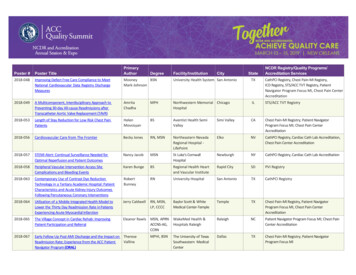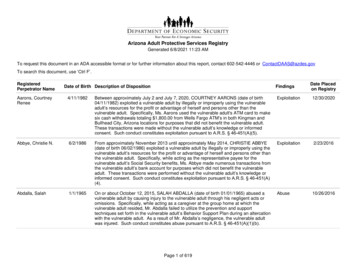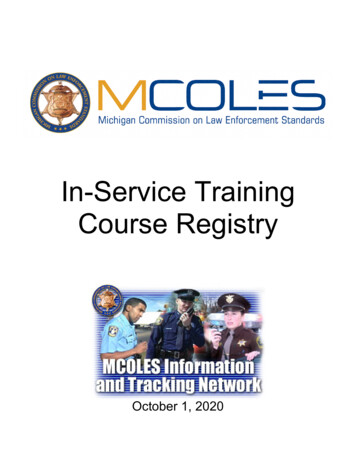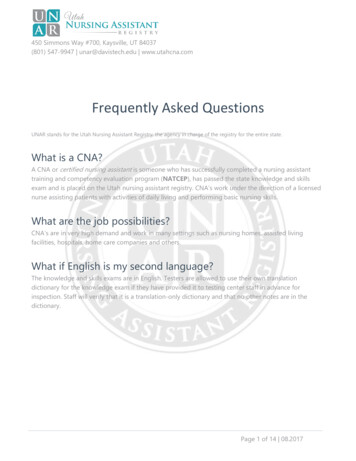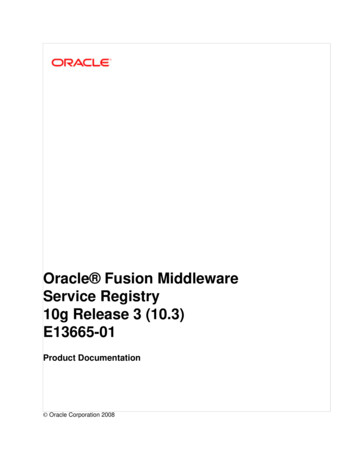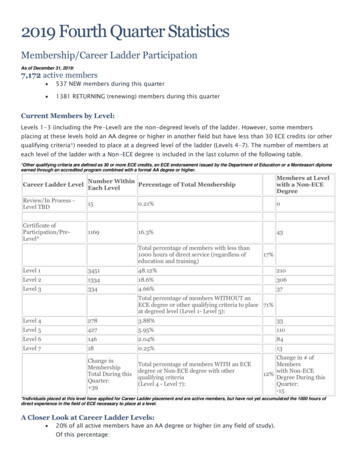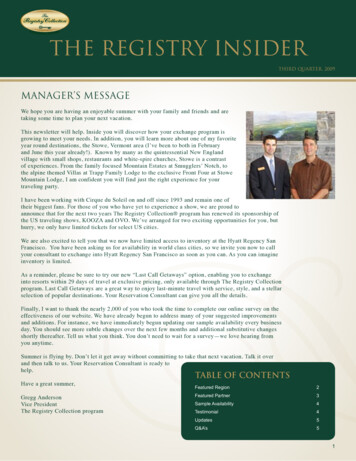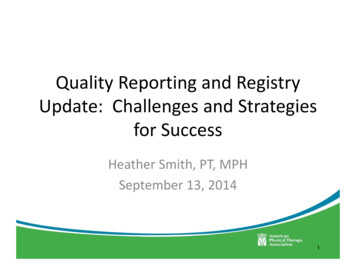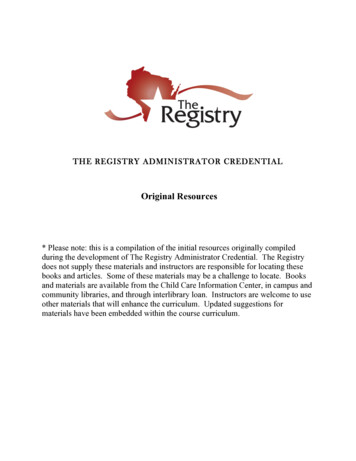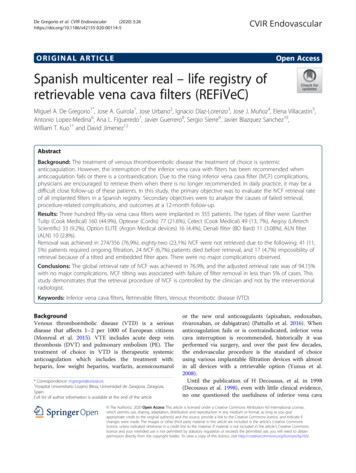
Transcription
De Gregorio et al. CVIR Endovascular(2020) 3:26https://doi.org/10.1186/s42155-020-00114-5CVIR EndovascularORIGINAL ARTICLEOpen AccessSpanish multicenter real – life registry ofretrievable vena cava filters (REFiVeC)Miguel A. De Gregorio1*, Jose A. Guirola1, Jose Urbano2, Ignacio Díaz-Lorenzo3, Jose J. Muñoz4, Elena Villacastin5,Antonio Lopez-Medina6, Ana L. Figueredo7, Javier Guerrero8, Sergio Sierre9, Javier Blazquez Sanchez10,William T. Kuo11 and David Jimenez12AbstractBackground: The treatment of venous thromboembolic disease the treatment of choice is systemicanticoagulation. However, the interruption of the inferior vena cava with filters has been recommended whenanticoagulation fails or there is a contraindication. Due to the rising inferior vena cava filter (IVCF) complications,physicians are encouraged to retrieve them when there is no longer recommended. In daily practice, it may be adifficult close follow-up of these patients. In this study, the primary objective was to evaluate the IVCF retrieval rateof all implanted filters in a Spanish registry. Secondary objectives were to analyze the causes of failed retrieval,procedure-related complications, and outcomes at a 12-month follow-up.Results: Three hundred fifty-six vena cava filters were implanted in 355 patients. The types of filter were: GuntherTulip (Cook Medical) 160 (44.9%), Optease (Cordis) 77 (21.6%), Celect (Cook Medical) 49 (13, 7%), Aegisy (LifetechScientific) 33 (9.2%), Option ELITE (Argon Medical devices) 16 (4.4%), Denali filter (BD Bard) 11 (3.08%), ALN filter(ALN) 10 (2.8%).Removal was achieved in 274/356 (76,9%). eighty-two (23,1%) IVCF were not retrieved due to the following: 41 (11,5%) patients required ongoing filtration, 24 IVCF (6,7%) patients died before retrieval, and 17 (4,7%) impossibility ofretrieval because of a tilted and embedded filter apex. There were no major complications observed.Conclusions: The global retrieval rate of IVCF was achieved in 76.9%, and the adjusted retrieval rate was of 94.15%with no major complications. IVCF tilting was associated with failure of filter removal in less than 5% of cases. Thisstudy demonstrates that the retrieval procedure of IVCF is controlled by the clinician and not by the interventionalradiologist.Keywords: Inferior vena cava filters, Retrievable filters, Venous thrombotic disease (VTD)BackgroundVenous thromboembolic disease (VTD) is a seriousdisease that affects 1–2 per 1000 of European citizens(Monreal et al. 2015). VTE includes acute deep veinthrombosis (DVT) and pulmonary embolism (PE). Thetreatment of choice in VTD is therapeutic systemicanticoagulation which includes the treatment with:heparin, low weight heparins, warfarin, acenocoumarol* Correspondence: mgregori@unizar.es1Hospital Universitario Lozano Blesa, Universidad de Zaragoza, Zaragoza,SpainFull list of author information is available at the end of the articleor the new oral anticoagulants (apixaban, endoxaban,rivaroxaban, or dabigatran) (Pattullo et al. 2016). Whenanticoagulation fails or is contraindicated, inferior venacava interruption is recommended, historically it wasperformed via surgery, and over the past few decades,the endovascular procedure is the standard of choiceusing various implantable filtration devices with almostin all devices with a retrievable option (Yunus et al.2008).Until the publication of H Decousus, et al. in 1998(Decousus et al. 1998), even with little clinical evidence,no one questioned the usefulness of inferior vena cava The Author(s). 2020 Open Access This article is licensed under a Creative Commons Attribution 4.0 International License,which permits use, sharing, adaptation, distribution and reproduction in any medium or format, as long as you giveappropriate credit to the original author(s) and the source, provide a link to the Creative Commons licence, and indicate ifchanges were made. The images or other third party material in this article are included in the article's Creative Commonslicence, unless indicated otherwise in a credit line to the material. If material is not included in the article's Creative Commonslicence and your intended use is not permitted by statutory regulation or exceeds the permitted use, you will need to obtainpermission directly from the copyright holder. To view a copy of this licence, visit http://creativecommons.org/licenses/by/4.0/.
De Gregorio et al. CVIR Endovascular(2020) 3:26filter (IVCF) for the prophylaxis and treatment of VTD(Proctor and Greenfield 2008; Athanasoulis et al. 2000;Stein et al. 2004; Dalen and Stein 2013). It wasDecousus, et al. and the PREPIC study (PREPIC StudyGroup 2005) that demonstrated that IVCF represents apotential benefit with protection against life-threateningpulmonary embolism in a short-term; however, with ahigher risk of symptomatic DVT in a long-term withoutmortality difference at 8 years of follow-up. Therefore,the use of IVCF decreased in Europe (PREPIC StudyGroup 2005; Reddy et al. 2017; Wadhwa et al. 2017).The arrival of new retrievable IVCF increased the indications for filter placement, to provide protection againstPE in the short-term while avoiding the long-term DVTrisks by removing the filter in a short period. In the pastdecade, it has encountered a rising complication in theIVCF placement reported in the United States, MAUDEdatabase (Amendola and Acosta 2016), that resulted in aSafety Alert issued by the FDA in 2010 (Morales et al.2013). This safety alert encourages physicians and clinicians responsible for the care of patients with IVCF, toconsider removing the filters when there was no longeran indication of inferior vena cava interruption. (Amendola and Acosta 2016; Food and Drug Administration2011) However, in daily clinical practice, it may be difficult to follow patients closely and prompt filter removal.We present the results of a multicenter prospectiveregistry involving 15 tertiary Spanish hospitals using aprotocol to facilitate close patient follow-up for promptfilter removal.The primary objective of this study was to evaluate allthe inferior vena cava filter (IVCF) retrieval rate of implanted IVC filters. Secondary objectives were to analyzethe causes of failed retrieval, procedure-related complications, and outcomes at a 12-month follow-up.Material and methodsThe SERVEI-REFiVeC (Registro Español de Filtros enVena Cava Inferior) Registry is a prospective multicenterstudy endorsed by the Spanish Society of Vascular andInterventional Radiology (SERVEI) and by the ZaragozaUniversity. This Registry received institutional reviewboard approval in May 2016 (CP-CI number PI16 /0142), and the study was registered in Clinical Trial Gov(NCT02757001). The registry was open from 01 to 0416 until 01–04-18. The form was designed by theresearch group (GITMI) of the University of Zaragoza.An electronic patient report form was specificallydesigned for this registry and hosted on the SpanishSociety of Vascular and Interventional Radiology (SERVEI),webpage (Sociedad Española Radiología Intervencionista(SERVEI), estudios y registros 2020).This was open to all members of SERVEI society, afteridentification and acceptance by the study principalPage 2 of 9investigator (PI), and all of the interventional radiologists(IRs) had at least 5 years in experience for the placementand retrieval of IVCF. Over 2 years, all patients with anIVCF implantation were consecutively enrolled by anelectronic registry. The following data were gathered:demographics, VTE risk factors, filter placement indications, IVCF type, filter dwell time, number of retrievalattempts and retrieval outcome (Table 1). The follow-upwas carried out at least 1 year and determined if an appearance of PE or DVT. In case of clinical suspicion ofPE or DVT, pulmonary CT angiography was performedfor the suspicion of PE or ultrasound- Doppler for DVT.Complications were classified according to CIRSE standards (Filippiadis et al. 2017). The study was conductedfollowing the “Strengthening the Reporting of Observational Studies in Epidemiology (STROBE) Statement:guidelines for reporting observational studies (von Elmet al. 2007).Statistical analysisWe used chi-square or Fisher’s exact tests to compare categorical data between groups. We used the Shapiro-Wilktest to assess continuous data for a normal distribution.We used two-tailed unpaired t-tests to compare parametric continuous data between two unpaired groups,and we used the Mann-Whitney U test for nonTable 1 Registry form. Data points included in the registryIdentificationNumberSexAgeRisk factorsFilter indicationTechnical dataAccessFilter typeFilter implantation dateRecovery attemps1,2,3 Death before recoveryYes /NOAnticoagulant treatmentYes /NORecovery accessYugular vein (R/L)Femoral vein (R/L)OthersRecovery with manufacturerrecommended setSet recommended by themanufacturerRecovery with other maneuversSnare, ballooms, cocodrileclips, graspingCause of inability to filter recoverTilt, leg penetration, fibrosis,thrombosis, death, othersFollow-up3, 6, 12 monthsRecurrence pulmonaryembolism, other causes
De Gregorio et al. CVIR Endovascular(2020) 3:26Page 3 of 9parametric data comparisons. We conducted statisticalanalyses using STATA version 13.1 (STATA Corp, College Station, Texas). All hypothesis tests were two-sided,with a significance level of 0.05.The registry was designed to enroll at least 200 patients with IVCF and recorded clinical follow-up at leastone year after recovery, evaluating possible episodes ofrecurrent PE, DVT or possible death of the patient.ResultsDemographicsFrom April 2016, until April 2018, three hundred fiftysix vena cava filters were implanted in 355 patients (1patient received two filters for having double vena cava).The mean age was 59.7 13.7 years (range 89–19 years.One hundred and eighty-two (51.1%) patients were menand 174 (48.8%) women, 15 Spanish tertiary hospitalsparticipated in the REFiVeC registry. The average IVCFimplantation in each center was 23.6 25.9 (range 101–1 IVCF). The types of filter used in the registry were:Gunther Tulip (Cook Medical) 160 (44.9%), Optease(Cordis) 77 (21.6%), Celect (Cook Medical) 49 (13, 7%),Aegisy (Lifetech Scientific) 33 (9.2%), Option ELITE(Argon Medical devices) 16 (4.4%), Denali (BD Bard) 11(3.08%), ALN filter (ALN) 10 (2.8%).IndicationsVTD risk factors included immobilization in 197(55.4%), neoplasm in 55 (15.4%), recent surgery in 46(12.9%), history of VTE in 35 (9.8%) and contraceptiveuse in 24 (6.7%). Of the patients who required a venacava filter, 309 had one risk factor for VTD, 43 had tworisk factors, and 4 had more than two risk factors. Themain indications for IVCF were: presence of VTE withcontraindication to anticoagulation in 188 (52.8%), Prevention in high-risk patients with DVT in 120 (33.7%),(in this case, 54 patients suffered massive PE, 49 sufferediliofemoral DVT and 17 COPD and DVT), and recurrentPE despite anticoagulation in 48 (13.4%) (Table 2).Access and imagingThe access route used for the implantation of the filterwas: the right internal jugular vein in 180 cases (50.5%),the right femoral vein in 148 (41.5%), the left femoralvein in 25 (7.02%) and the left internal jugular vein in 2(0.5%) cases. Cavography was performed in all patientsduring filter removal, 260 (73.03%) patients underwentabdominal computed tomography before IVCF retrieval.The indication of abdominal CT was to facilitate withdrawal (knowing the inclination, the presence of thrombosis or migration) and was performed on the same daybefore the IVCF retrieval. The abdominal CT, 185(71.1%) patients had normal findings regarding the position and tilt of the filter; in 41 (15.7%) patients tilting ofthe IVCF was appreciated 15 with the IVC, in 12(4.6%) patients IVCF tilt was found 15 . Penetration ofthe legs in the IVC 3 mm was appreciated in 2 (0.76%)patients, inclusion of the superior hook in the wall ofthe IVC or some other element of the filter was observedin 16 (56.1%) patients, and in 4 (1, 5%) patients had evidence of thrombosis of the IVCF. Three hundred andone (84.5%) patients were receiving anticoagulation therapy at the time of filter removal, and 55 (154%) patientswere not anticoagulated.Retrieved IVCFA total of 274/356 (76.9%) filters were successfully removed. Figure 1 shows the distribution of the retrievedIVCF. In eighty-two (23,0%) patients, the filters were notremoved, in 41 patients (11,5%) the retrievable filterswere left in as permanent filters (12 patients with advanced neoplasm, 11 patients refused removal, 13 patients were older than 70 years and ongoing filtrationwas desired due to comorbidities, and five patients werelost to follow up). In twenty-four (6,7%) patients, theIVCF was not removed since the patients died duringthe follow-up interval at a mean of 18.9 9.6 days (range2–36 days). Retrieval was not possible in seventeen patients (4,7%) due to a tilted ( 15 ) and embedded filterapex. Table 3 shows the IVCF dwell time. The meandwell time was 44.8 170.4 days, a median of 31 daysTable 2 The main indication for Inferior Vena Cava FiltersIndicationsDirect causenN%Prevention in high risk patients with DVT- EP massive treated with fibrinolysis o thrombectomy5412033,718852,84813,4- Iliofemoral DVT- COPD DVTContraindication for anticoagulationRecurrence of pulmonary embolism while receiving anticoagulation- Recente bleeding4917104- Recent surgery42- Brain tumor /Recent stroke27- Severe trauma15
De Gregorio et al. CVIR Endovascular(2020) 3:26Page 4 of 9Fig. 1 Diagram showing the distribution of inferior vena cava filters. Filters retrieved successfully and unable to retrieve filters with their causes(ranging 1–2920 days). Table 4 shows the number andthe percentage of each type of filters that were not recovered, as a result of the patients had died, could notbe retrieved or because they were left as permanentfilters.Difficulties and complicationsRemoval difficulties occur in 26 patients (7.3%) (mainlyrelated to tilting 15 and inclusion of the upper hookor some structure in the wall of the IVC.Special endovascular maneuvers were performed to retrieve filters with an average of 2.8 maneuvers, with arange of 1–4 additional maneuvers (femoral-jugulardouble access, Snare-Loop Technique, the HangmanTechnique) and repeated attempts at recovery in 9/26patients, IVCF was recovered with an average of 2.1 attempts (range 1–3). Despite several attempts (average2.5 and 1–3 range) in 17/26 patients, IVCF could not berecovered and was left as permanent filters (Fig. 2)(Table 5). Of the IVCF defined as retrievable filters(without patients who died and those who for variousreasons were left as permanent filters), the global removal success was 76.96%. When comparing the dwelltime of the filters extracted successfully and in which itfailed, the average period was 35.2 15 days with a median 32 days for the extracted ones versus 65 56 dayson average with a median of 48 days in the that failed(p 0.0011). IVCF thrombosis was observed in fourpatients (1.2%). After fibrinolysis in two patients andthromboaspiration in 2, the filter could be removedwithout any complications. Complications were found in12 patients (3.3%): 6 neck hematomas and 5 groinhematoma, (type I complication) (Filippiadis et al. 2017).Accidental carotid punctured in 1 patient, whichTable 3 Days until the filter was retrieved in each type of filter, either satisfactorily or failed as well as the range (maximum andminimum days for each type of filter)Filter (356)N%Mean days until retrievalRange daysSuccessfulFailedMinMaxpGunther Tulip (Cook)16044,9146/64,62/87,512920 0.01Optease (Cordis)7721,644/29,111/48,091298 0.01Celect (Cook)4913,742/ 41,12/15119270 0.01Aegisy (Lifetech339,220/14,91/1311270.05Option ELITE (Argon)164,411/32,31/2826410.01Denali (Bard)113,088/310/026350.04ALN Filter (ALN)102,88/32,30/0263660.04TOTAL35612920
De Gregorio et al. CVIR Endovascular(2020) 3:26Page 5 of 9Table 4 Distribution by type of filter (Successful withdrawal or failure, as well as filters that could not be removed because thepatient died during their hospital stay or for various reasons, were left as permanent filters)FilterN%SuccessfulGunther Tulip (Cook)16044,9146 /91,2%2/1,2%9/5,6%2/1,2 0.01Optease (Cordis)7721,642/54,5%11/14,2%6/7,7%17/22,0% 0.01Celect (Cook)4913,742/85,7%2/4,0%2/4,0%2/4,0% 0.01Aegisy (Lifetech339,220/60,6%1/3,0%3/9,0%12/36,3% 0.1Option ELITE (Argon)164,411/68,7%1/6,25%1/6,2%4/25%0.05Denali N Filter 2441p* Patients died before inferior vena cava filter was scheduled for retrievalrequired compression and admission of 24 h (type IIcomplication) (Filippiadis et al. 2017). In 276 (77.5%)patients, fluoroscopy time and Air Kerma were studied(Table 6).Follow-upIn 264 (74.1%) patients, follow-up time was 11.3 3.2months after IVCF recovery. All patients were treatedwith oral anticoagulation or low molecular weight between 6 and 8 months. There were 2 cases of recurrenceof PE after IVCF retrieval. Both were documented withpulmonary CT angiography, echocardiography, and biological markers. One of them, occurred when the patientwas not anticoagulated, and was classified as a lowintermediate risk for PE and was treated with new oralanticoagulant treatment. The other, a young patient,Fig. 2 Example of IVCF retrieval with difficulty. A 61-year-old female patient diagnosed with multiple myeloma. Six years ago she had DVT in herleft lower limb. She was treated with unfractionated heparin and had an upper-GI bleed, and anticoagulants became contraindicated. An Opteasefilter was implanted infrarenal. a. abdominal x-ray showed the Optease filter in a proper position. b. Abdominal CT with sagittal MPR showed thefilter slightly tilted on the vertical axis. c. Femoral access with a 16 Fr sheath and a 25 mm snare (Amplatz GooseNet snare). After several attempts,it was impossible to recover it. d. Jugular access was made with a 12 F sheath and a guide was passed through the upper vertex of the filter andwith several movements from both accesses, the IVCF was introduced into the sheath and the filter could be recovered. e. Cavography after filterretrieval (shows endothelial alteration). f. The filter recovered with endothelial remains
De Gregorio et al. CVIR Endovascular(2020) 3:26Page 6 of 9Table 5 Main causes of IVCF recovery failure and number retrieval attemptsFilterNFailedReasons for failedGunther Tulip (Cook)1602/1,2%-Tilt 15 , Hook included in IVC wall2- Hook and legs included in IVC wall3Optease (Cordis)77Celect (Cook)11/14,2%492/4,0%Recovery Attemps- Legs and structures included in IVC wall2 (5 pats)- Legs and structures included in IVC wall1 (6 pats.)-Tilt 15 , Hook included in IVC wall2- Tilt 15 , Hook included in IVC wall1Aegisy (Lifetech)331/3,0%- Legs and structures included in IVC wall1Option ELITE (Argon)161/6,25%-Tilt 15 , Hook included in IVC wall2Denali (Bard)110/0–ALN Filter (ALN)100/0–35617(Pats: Patients)diagnosed with hematologic disease and hereditarythrombophilia (homologous Leiden Factor V) wasdecided on the new placement of definitive filter andanticoagulation treatment for life.DiscussionThe SERVEI-REFiVeC registry is a study of 356 retrievable ICVFs in 355 patients, which gathers the activity offifteen major Spanish hospitals. This study has limitations since in Spain, there is no consensus, protocol orguidelines accepted by the different societies regardingVTD regarding placement and retrieval of IVCF. Interventional Radiologists are aware of the recommendations of the FDA and other administration to remove allfilters as soon as possible, once they are no longerneeded. The total recovery rate of FVCI in this studywas 76.9%, it might seem low if we compare it with thedata from the CIRSE Registry (De Gregorio et al. 2006)in which the recovery rate is 92%. Other nonmulticenter studies (De Gregorio MA et al.) (Sarosieket al. 2013)
1 IVCF). The types of filter used in the registry were: Gunther Tulip (Cook Medical) 160 (44.9%), Optease (Cordis) 77 (21.6%), Celect (Cook Medical) 49 (13, 7%), Aegisy (Lifetech Scientific) 33 (9.2%), Option ELITE (Argon Medical devices) 16 (4.4%), Denali (BD Bard) 11 (3.08%),


